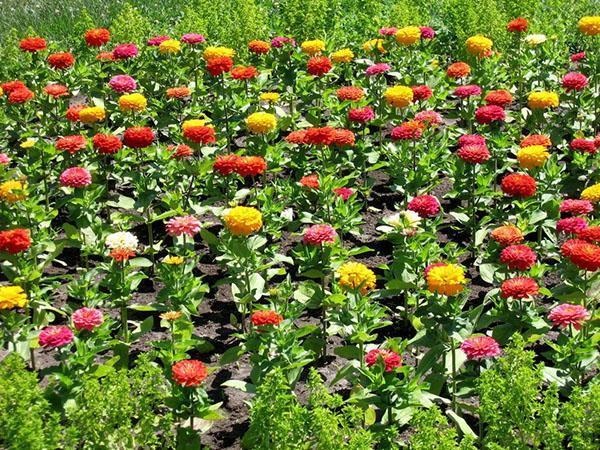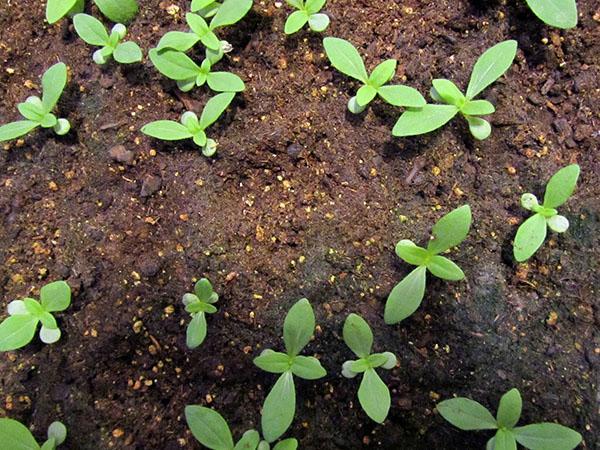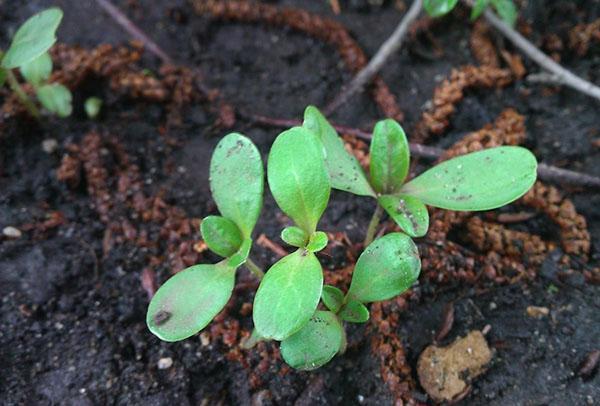Simple cultivation of zinnia in a flower bed of a summer cottage
 Growing zinnia is a fairly simple procedure that even the most inexperienced gardener can handle. In nature, the plant has many names, but most of all the flower is known as major. Zinnia gained its popularity due to its incredible decorative properties. The plant is perfect for growing near private houses and summer cottages.
Growing zinnia is a fairly simple procedure that even the most inexperienced gardener can handle. In nature, the plant has many names, but most of all the flower is known as major. Zinnia gained its popularity due to its incredible decorative properties. The plant is perfect for growing near private houses and summer cottages.
When to sow

You can grow a flower in several ways:
- sowing seedlings;
- sowing in open soil.
Both methods are effective if all requirements are met.
Sowing dates for zinnia seedlings depend, first of all, on the region. This procedure should be carried out only after the night frosts have completely stopped. This is often the end of May or the first week of June.
Before carrying out this procedure, you should determine the germination of seeds. To do this, the grains are wrapped in a napkin made of natural fabric, which is pre-soaked with epin. High-quality seeds will begin to hatch in two to three days. It is them that will need to be used in the future.
Zinnias: planting and caring for seeds in the open field
 Site selection plays an important role in growing this type of plant. Since zinnia is a light-loving crop, it should be planted in areas that are not hidden from the sun.
Site selection plays an important role in growing this type of plant. Since zinnia is a light-loving crop, it should be planted in areas that are not hidden from the sun.
The garden bed where the majors will grow must be protected from drafts.
As for the soil, the best option is a fertile soil that allows air and moisture to pass through well. Before planting seeds, you need to carefully prepare the site. The first thing to do is to clear the soil of the presence weeds... Then, for better germination of the grains and preventing future stagnation of water, it is recommended to add a small amount of sand to the soil. You can use both quarry and river.
As soon as the site looks good, the soil should be covered with polyethylene. This will create a greenhouse effect that will trap moisture.
You can sow grains in open ground in any geometric order. The main thing is to take into account the types of plants and their varieties, so that the flower bed looks harmonious and beautiful.
As for the holes, their depth should be about 5 cm. The seeds should be placed at a distance of 10 cm. These numbers must be observed, otherwise the plants will be thin. After 4 to 6 leaves appear, the seedlings must be thinned out, observing a distance of about 30 centimeters. For low-growing varieties, 20 centimeters will be enough.
Sowing zinnia seeds for seedlings
 Sowing seeds for seedlings should be carried out no earlier than in the month of April. The container for this procedure should be used deep and long. Purchased plastic flowerpots are perfect. But you can also make a container for planting yourself from the boards.
Sowing seeds for seedlings should be carried out no earlier than in the month of April. The container for this procedure should be used deep and long. Purchased plastic flowerpots are perfect. But you can also make a container for planting yourself from the boards.
If the timing of planting zinnia on seedlings was chosen correctly, then the first shoots can be observed for 7 days.
Proper planting and care of zinnia in containers will allow you to grow beautiful and healthy plants. Therefore, before placing the planting material in the soil, it should be remembered that the majors do not tolerate the pick very well.To avoid irreversible processes, grains must be located at a sufficient distance from each other.
As for the soil, you can use both purchased land and from the garden. The main thing is that the substrate is nutritious and loose.
Also, planting zinnia on seedlings can be carried out in individual flowerpots or disposable plastic cups. Some gardeners use peat tablets... Sprinkle the grains with a layer of soil no more than 1 cm thick. After this procedure, it is important to spray the soil abundantly with a spray bottle. Take water only at room temperature and well-separated.
For quick germination, it is recommended to cover the surface of the container with glass or transparent polyethylene. Until the seeds germinate well, the film should be removed daily, and the inside of it should be carefully wiped with a towel. This is required in order to remove condensation. After the sprouts appear, open the flowerpot and put it on the windowsill.
Seedlings need to be watered often, but not very abundantly. The topsoil must be checked before irrigation. This is due to the fact that zinnia does not like excess moisture. You can plant plants in open ground in the month of May.
Growing zinnia in a flower bed
The abundance of flowering does not depend on how the seeds were sown. The development and growth of majors is influenced by watering, feeding and loosening the soil. In other words, we can say that there is a special agricultural technique for growing zinnia.
How to properly pinch zinnia
 This is a very important procedure. Many budding gardeners don't know when to pinch zinnia. This should be done immediately after the plant is well rooted and grows up significantly. Only a small part of the crown should be removed. As a result, the stem will begin to bush. If you decide to grow tall majors, then this procedure is not necessary.
This is a very important procedure. Many budding gardeners don't know when to pinch zinnia. This should be done immediately after the plant is well rooted and grows up significantly. Only a small part of the crown should be removed. As a result, the stem will begin to bush. If you decide to grow tall majors, then this procedure is not necessary.
Irrigation and weed removal
 When watering flowers, one must not forget that excess moisture can cause rotting of the root system. As for dry days, this will practically not affect the bushes. This is due to the fact that the majors belong to the group of drought-resistant plants.
When watering flowers, one must not forget that excess moisture can cause rotting of the root system. As for dry days, this will practically not affect the bushes. This is due to the fact that the majors belong to the group of drought-resistant plants.
It is rarely necessary to irrigate adult plants, but quite abundantly. It all depends on the air temperature and the region in which they grow.
When watering, it is recommended to ensure that no liquid gets on the buds. This can damage the flowers.
For abundant flowering, remove all dry buds.
Fertilizer Majors
 In order for the flowers to grow well, it is recommended to fertilize the soil both before sowing and during development. During the digging of the site, humus and peat... Such fertilizer should be applied at the rate of 9-11 kg per 1 square meter.
In order for the flowers to grow well, it is recommended to fertilize the soil both before sowing and during development. During the digging of the site, humus and peat... Such fertilizer should be applied at the rate of 9-11 kg per 1 square meter.
Use of mineral preparations per 1 square meter:
- potassium sulfate two teaspoons;
- a tablespoon of superphosphate;
- a tablespoon of nitrophoska.
It is necessary to fertilize the majors both during the growth period and during the formation of buds. During the budding period, it is better to use liquid products and apply along with watering.
Collecting Zinnia Seeds Correctly
 You can start harvesting grains 8 weeks after the buds open. This should be done only after the boxes turn brown.
You can start harvesting grains 8 weeks after the buds open. This should be done only after the boxes turn brown.
The highest quality grains are found in the first row shoots.
To remove the pods from the stem, you need to use a sharp knife or scissors. Then remove dry grains and place in a paper envelope. In this state, they can be stored for three to four years.
Knowing when to plant zinnia and how to care for it will help you get the results you want. Only by observing all the requirements and rules, your site from spring to late autumn will delight you with incredible colors.